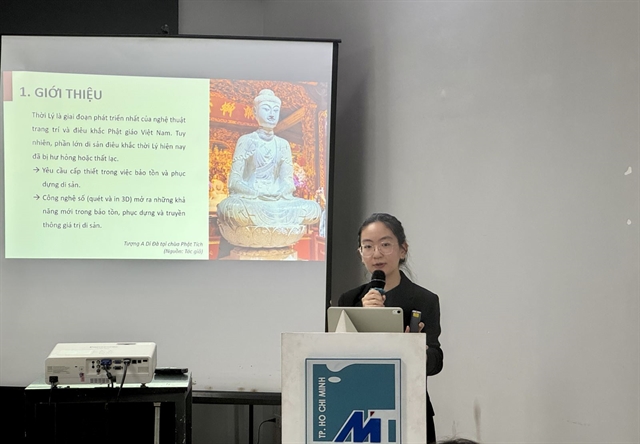In the digital age, AI and 3D technology are redefining how sculptors create. From modeling and scaling to precise 3D printing, technology has become a powerful creative tool, enabling artists to save effort, materials, and experimentation time.

Lecturer Tôn Nguyễn Tuyết Hoa from Văn Lang University talks about the reinterpretation of the cultural values of Lý Dynasty (1009–1225) sculpture through 3D scanning and printing technology. — VNA/VNS Photo Hương Trần
HÀ NỘI — Artificial intelligence (AI) and 3D technology are transforming every field of creativity, opening new possibilities for art, including sculpture, a form traditionally tied to manual labour and intuitive emotion.
In the digital age, AI and 3D tools are redefining how sculptors create. From modelling and scaling to precise 3D printing, technology has become a powerful creative tool, enabling artists to save effort, materials and experimentation time.
“Thanks to artificial intelligence, sculptors can enlarge their works to actual size, something that could previously only be done through imagination. AI also assists with perspective, materials, lighting and more, allowing artists to easily experiment with various creative possibilities without excessive material and labour costs,” said Professor Dr Nguyễn Xuân Tiên, chairman of the HCM City Fine Arts Association.
“Technology is merely a supporting tool, not a saviour. Artists must learn, understand and use technology to avoid losing themselves and their cultural identity.”
According to sculptor Lâm Quang Nới, the emergence of AI and 3D simulation software has helped the process of refining artworks and “reduced effort by up to 50 per cent.”
He added that AI is effectively handling post-production stages, not only in sculpture but also in photography, exhibition and preservation, thereby creating easier access to art for the public.

Digital technology and artificial intelligence are being applied by artists in their works. — VNA/VNS Photo Hương Trần
In Việt Nam, the Centre for Preservation of the Ancient Capital of Huế and the Chăm Sculpture Museum in Đà Nẵng are also applying digital technology in preservation, expanding the potential for promoting heritage to the public.
Lecturer Tôn Nguyễn Tuyết Hoa from Văn Lang University noted that technology helps researchers "preserve the physical memory" of ancient statues, bas-reliefs and archaeological sites more accurately and sustainably, laying the groundwork for education and the restoration of traditional culture in the future.
However, the specialists are also concerned about the overuse of technology in sculpturing.
“While technology offers countless conveniences, it also carries the risk of desensitising art when creation becomes too easy, too precise and too perfect. This raises questions among many artists: how can we retain the human essence in a world supported by machines?” Hoa asked.
According to sculptor Lê Lang Biên, head of the Sculpture Department at the HCM City Fine Arts Association and an artist pursuing contemporary sculpture, AI can simulate shapes and personal styles, but it cannot replace human intuition and aesthetic thinking.
“Sculpture is a dialogue between humans and materials, between breath, emotion and contemplation. If that dialogue is lost, art will become soulless,” he said.
He believed that today’s artists need to coexist with technology rather than let it lead.
“AI should be a companion that helps expand creative boundaries, not a decision-maker in place of the artist,” he added.
From an educational perspective, M.A. Lê Ngô Quỳnh Đan, a young lecturer in sculpture, reckoned that the greatest challenge for the younger generation of sculptors is to harmonise digital techniques with genuine emotion.
According to her, art education in the age of AI needs to guide students back to fundamentals, which are human philosophy, cultural identity and the artist's emotions.
Experts also agree that in the context of strong urbanisation and globalisation, Vietnamese sculpture needs to pay more attention to public spaces, heritage and urban memory. Each artwork is not only an artistic object but also a “visual memory” of the community, preserving the culture, spirit and soul of Việt Nam.
“Sculpture is the memory of the city. When technology helps us recreate and preserve, it offers an opportunity to spread aesthetic values to the community. However, if artists become dependent on technology, they will lose themselves,” said Professor Dr Tiên, chairman of the HCM City Fine Arts Association.
Ultimately, while technology can create perfect shapes, only genuine emotions can breathe life into them. As sculptor Lê Lang Biên said: “A sculpture truly lives only when the viewer can feel the heartbeat of its creator.” — VNS